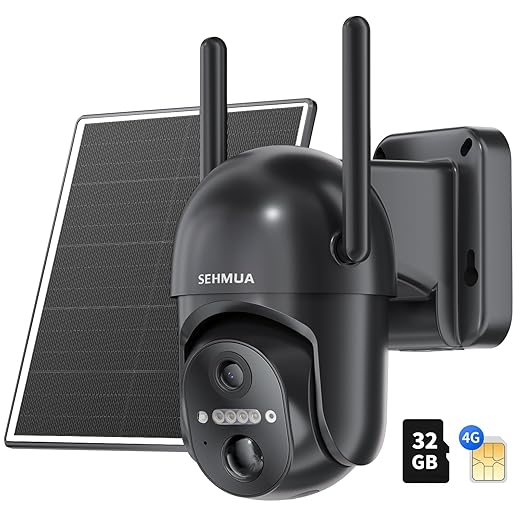Introduction to Cellular Security Cameras
In an age where SECURITY is more important than ever, cellular security cameras have emerged as a revolutionary solution. Unlike traditional wired systems, these cameras utilize cellular networks to transmit video and audio, providing real-time monitoring regardless of location. This mobility and convenience are game-changers for home security.
This article delves into the key features that define quality cellular cameras, helping readers understand what to look for when making a selection. It also offers a comprehensive comparison of top cellular camera models, showcasing their unique strengths and limitations.
Furthermore, the discussion will highlight real-world applications, illustrating how these cameras can enhance safety and peace of mind in various settings. Lastly, the article will evaluate cost considerations and energy efficiency, ensuring homeowners make informed decisions for their security needs. Join as we navigate the exciting future of surveillance technology!
Amazon.com
Understanding Cellular Security Cameras
Cellular security cameras are innovative devices designed to enhance surveillance through cellular network connectivity. By using a SIM card to connect to 4G or even 5G networks, these cameras can send video feeds directly to the user’s device, eliminating the dependence on Wi-Fi networks. This feature makes them ideal for both rural and urban environments, where Wi-Fi might be unreliable, unavailable, or facing interference.
The Technology Behind Cellular Cameras
At the heart of cellular cameras lies a simple yet effective technology: mobile data. Once installed, these cameras can transmit high-definition video and audio recordings through cellular networks. This allows for real-time monitoring and alerts, accessible via smartphone apps or cloud services. Because they operate independently of local Wi-Fi, users can position them in hard-to-reach locations, ensuring that no corner of their property is left unmonitored.
Advantages of Cellular Connections
- Reliability: Cellular security cameras provide robust connections that are less susceptible to outages caused by power failures or interruptions in local internet service. This makes them an excellent choice for continuous monitoring.
- Remote Access: Users can access live feeds and stored footage from anywhere in the world, be it on vacation or during a business trip. This flexibility gives homeowners peace of mind, knowing they can keep an eye on their property whenever needed.
- Ease of Installation: Unlike traditional wired systems that require professional installation and complex setups, cellular cameras can often be installed by the homeowner in a matter of minutes. This makes them particularly attractive for those who prefer a DIY approach.
- Security Against Tampering: Many cellular cameras feature built-in backup battery systems, ensuring they continue to function even if the power goes out or the camera is tampered with.
Practical Applications
The utility of cellular security cameras extends far beyond typical home use. They are increasingly being adopted in various scenarios, such as construction sites needing remote monitoring, vacation homes where owners want to ensure everything is in order, or even farms that require surveillance across expansive properties.
For instance, someone with a vacation cabin may set up a cellular camera to monitor for intrusions or wildlife activity. They enjoy the benefit of real-time alerts, allowing them to maintain a secure environment even when miles away.
The next section will delve deeper into key features to look for in cellular security cameras, guiding readers on how to choose the right model for their specific needs.
Key Features to Look for in Cellular Security Cameras
When selecting a cellular security camera, homeowners should focus on several critical features that ensure practicality, efficiency, and ease of use. The right choice can significantly enhance peace of mind, enabling effective monitoring of properties. Here are some essential aspects to consider:
Video Quality
The clarity of the video feed is paramount. Most modern cellular cameras offer high-definition video, typically ranging from 1080p to 4K. Higher resolutions ensure that important details, like facial features or license plates, are easily discernible. This clarity is particularly useful for identifying potential intruders or monitoring pet activities around the home.
Night Vision Capabilities
Security doesn’t stop after sundown. Efficient night vision technologies, such as infrared (IR) or color night vision, enable cameras to capture clear images in low-light conditions. Homeowners should look for models that specify effective ranges for their night vision capabilities, which can significantly aid in keeping an eye on properties during the night.
Motion Detection
Feature-rich cellular cameras boast advanced motion detection capabilities. They can differentiate between regular movement and potential threats, reducing false alarms caused by pets or passing cars. Some models send instant alerts or notifications to the homeowner’s smartphone, allowing for timely responses to unauthorized actions. Enhanced features may include customizable motion zones, keeping alerts focused on critical areas such as driveways or entrance points.
Storage Options
Storage is another crucial consideration. Cellular cameras typically offer two storage solutions: cloud storage and local storage (such as SD cards). Cloud storage is convenient, allowing for remote access and automatic backups but often comes with subscription fees. Local storage, on the other hand, can be cost-effective but may require manual retrieval of footage. Homeowners should evaluate how much storage they might need and the associated costs before making a decision.
Integration with Smart Home Systems
As homes become smarter, so should their security systems. Many cellular cameras can integrate seamlessly with other smart devices, such as alarms, door locks, and smart speakers. This interconnectedness enhances overall home security and allows for centralized control, streamlining the management of various devices through a single platform.
In summary, a careful evaluation of these features—video quality, night vision capabilities, motion detection, storage options, and integration with smart home systems—will help homeowners make informed decisions when selecting a cellular security camera.
As technology continues to evolve, the next section will highlight how these features come together in some of the top cellular camera models, offering side-by-side comparisons to help readers determine the best fit for their needs.
Comparing Top Cellular Camera Models
In the ever-evolving landscape of security technology, various cellular camera models stand out for their unique features, practicality, and overall performance. This section delves into several popular choices, providing insights that assist homeowners in choosing the camera that best meets their security needs.
Blink Outdoor 4 Wireless Camera System
The Blink Outdoor 4 is a compact, weather-resistant camera designed for outdoor surveillance. It boasts a 1080p HD video resolution, enabling clear images day and night thanks to its infrared night vision capabilities. With a two-year battery life and customizable motion detection zones, this camera is perfect for savvy homeowners looking for versatility without compromising on battery life. Its easy installation process and compatibility with Alexa devices make it an attractive option for those integrating smart home systems.
Reolink Go PT
The Reolink Go PT takes monitoring to the next level with its pan-and-tilt capabilities, allowing users to adjust the camera angle remotely through its app. With a 1080p HD image quality and a 130-degree viewing angle, it covers extensive areas and is especially useful for larger properties. It operates on both 4G LTE and Wi-Fi, providing reliable connectivity options. Additionally, the Reolink Go PT includes a solar panel charging option, ensuring continuous operation without needing frequent battery changes—a significant advantage in energy efficiency.
Arlo Go 2
Arlo Go 2 is celebrated for its advanced features and user-friendly interface. This camera delivers 1080p HD video with color night vision, providing high-quality images even in low light. Its 160-degree field of view enhances coverage, allowing users to spot movement from wider angles. The built-in spotlight and siren enhance security by deterring potential intruders. With its optional solar panel kit, the Arlo Go 2 achieves impressive energy efficiency and low maintenance. However, users should consider its monthly subscription service for cloud storage, which could impact overall costs.
Ring Stick Up Cam Solar
The Ring Stick Up Cam Solar is an eco-friendly option that combines functionality with sustainability. This camera also offers 1080p HD video and two-way audio, promoting interactive monitoring where homeowners can communicate with visitors or deter unwanted guests. Utilizing solar energy, it reduces electricity reliance and is particularly useful for areas with limited power sources. The Ring ecosystem supports extensive integration with other smart home devices, making it a practical choice for homeowners who appreciate seamless connectivity.
Eufy Security SoloCam E40
Lastly, the Eufy Security SoloCam E40 showcases high-quality performance in a user-friendly package. It features 2K resolution for superior image clarity and boasts intelligent human detection, which significantly minimizes false alarms. Eufy also eliminates monthly fees for cloud storage, providing users with local storage options instead, making it financially attractive in the long run. Although it doesn’t have a pan-tilt function or solar charging, its overall cost-effectiveness and simplicity make it appealing to many homeowners.
This comparison of popular cellular camera models highlights their individual strengths and ideal use cases, providing a clearer picture of what each can offer in practical settings.
As these varied features come into play, the next section will explore real-world applications of cellular security cameras, illustrating how they enhance safety and security across different environments.
Real-World Applications: Where Cellular Cameras Shine
Cellular security cameras are redefining how individuals approach surveillance by offering flexible, reliable solutions across numerous real-world scenarios. From monitoring vacation homes to safeguarding construction sites and providing care for elderly family members, these cameras enhance security through practical applications.
Vacation Homes: Peace of Mind from Anywhere
For owners of vacation properties, cellular cameras offer the ability to monitor their homes remotely. Imagine a family enjoying a ski trip, confident that they can check in on their cabin through their smartphone. With real-time alerts for unusual activity and two-way audio capabilities in advanced models, owners can easily communicate with neighbors or local authorities if necessary. This proactive monitoring can deter unwanted visitors and ensure that properties remain safe during the off-season.
Construction Sites: Securing Valuable Assets
Construction sites are often targets for theft, making security crucial. Cellular cameras empower site managers to keep an eye on tools, equipment, and materials, even when they’re off-site. For example, a project manager can receive alerts when motion is detected after hours, enabling quick responses to potential security breaches. The flexibility of installation allows placement in remote areas where Wi-Fi signals might be weak, ensuring thorough coverage.
Elderly Care: Monitoring Loved Ones
Cellular cameras also play a vital role in ensuring the safety of elderly family members living alone. By installing a camera in the home of an aging relative, family members can check in on them, ensuring their wellbeing without being intrusive. These cameras can be equipped with features like motion detection and emergency alerts, which notify caregivers if a loved one falls or remains inactive for an extended period. This not only enhances safety but also provides peace of mind to families concerned about their elderly relatives.
Farms and Rural Properties: Extensive Surveillance
For those managing farmland or rural properties, cellular cameras offer a robust security solution over large areas where traditional network coverage may be limited. They can be strategically placed to monitor livestock, crops, or equipment, facilitating early detection of potential threats, like trespassers or wildlife. Farmers can receive updates directly to their smartphones, allowing them to act quickly, thus minimizing losses and improving overall farm security.
The versatility of cellular security cameras stands out in these varied applications. As homeowners and businesses continue to discover the benefits of these devices, the next focus will delve into cost considerations and energy efficiency, exploring how these factors influence the choice of cellular cameras.
Cost Considerations and Energy Efficiency
When investing in cellular security cameras, understanding the financial implications is crucial. This section will unpack the costs associated with these devices, ranging from initial purchase prices to ongoing monthly fees, as well as their potential benefits in terms of energy efficiency—especially important for eco-conscious consumers.
Initial Purchase Costs
The upfront cost of cellular security cameras can vary significantly based on features and brand reputation. Basic models can start at around $100, while more sophisticated cameras, like the Reolink Go PT, which offers pan-and-tilt capability and solar power options, can escalate above $300. Homeowners should weigh the initial investment against the features offered, particularly those that enhance security and usability, ensuring that their choice aligns with personal needs and budgets.
Monthly Data Plans
In addition to upfront costs, homeowners often face ongoing expenses related to data plans. Many cellular cameras operate on mobile networks, necessitating a monthly subscription for data. These plans generally range from $5 to $30 per month, depending on the provider and the amount of data used. For example, Arlo and Ring offer competitive pricing on their subscription services, which, while an added cost, provide essential services like cloud storage and advanced AI features. Consumers should factor these recurring costs into their security budget, balancing the need for continuous monitoring with affordability.
Home Insurance Savings
Another financial aspect to consider is the potential for savings on home insurance. Many insurance providers offer discounts for homeowners who utilize security systems, including cellular cameras. By investing in a reliable security camera system and providing proof of installation, homeowners can negotiate lower premiums. This aspect can help offset the overall costs of the camera system, making it a financially sound investment in the long term.
Energy Efficiency
Energy efficiency is also a vital consideration, particularly for those aiming to minimize their environmental impact. Many modern cellular cameras, like the Ring Stick Up Cam Solar, feature solar charging capabilities, significantly reducing energy consumption. These devices harness sunlight to maintain battery levels, which can be a game-changer for installations in remote areas where electrical outlets are scarce. Moreover, energy-efficient cameras can lower electricity bills, solidifying their appeal for environmentally responsible consumers.
Consumers should also evaluate power consumption specifications when selecting a camera. Models with low standby power usage can have a substantial impact over time, ultimately resulting in decreased energy costs and a smaller carbon footprint.
In summary, while the initial purchasing and ongoing costs can add up, homeowners can save money through insurance discounts and energy-efficient technologies.
As the discussion of financial aspects and sustainability wraps up, the final considerations will focus on how to select the most suitable cellular security camera for individual needs—leading us into the conclusion of this informative exploration.
Conclusion: Choosing the Right Cellular Security Camera
In conclusion, selecting the right cellular security camera involves a careful evaluation of individual security needs and preferences. As discussed, understanding the technology, prioritizing key features, and weighing cost considerations are crucial steps in making an informed decision. Notably, potential buyers should consider how their unique environments and lifestyles impact their choices, ensuring that they invest in a model that enhances their security without compromising on usability or energy efficiency.
Ultimately, the ideal cellular camera should not only meet practical requirements but also align with personal values regarding safety and convenience. Readers are encouraged to explore their options, keeping in mind that the right choice can provide peace of mind and protect what matters most.











I just bought the Blink Outdoor 4 Smart Security Camera System, and I’m impressed so far! The setup was super easy, and the picture quality is way better than my last camera. I really love the night vision feature! 😍 But I wish it had more customizable alerts. Has anyone else tried it? What did you think?
I have the same one! The night vision is a game changer for sure. But yeah, the alerts could be more specific. I keep getting alerts for leaves blowing, lol! 🍃
Thanks for sharing your experience, Sarah! The customizable alerts are something we hear about often. It’s a feature many users want to see improved.
I’m loving this article! It’s super helpful for someone like me who’s clueless about tech. I was wondering about battery life for these cameras? Do they last long?
The battery life varies by model, but I’ve seen some last for months on a single charge, especially the solar ones. Just check the specs for each!
Thanks for the feedback, Maya! Battery life is definitely a crucial factor to consider, especially for cellular models.
I’ve been reading about the Enabot EBO SE and how it’s an indoor camera. But what’s the actual difference between indoor and outdoor models? Can I just use one for both?
Indoor cameras usually have less weatherproofing and are designed for different scenarios, like monitoring pets or kids. So, I’d stick to using them as intended!
Exactly, Jessie! Indoor cameras are optimized for different functionalities compared to outdoor ones, which need to withstand the elements.
I’m really interested in the cost aspect of these cameras. Some are super expensive! Is it worth it to invest in high-end ones over the budget options? I’m torn. 🤷♀️
I think it depends on what you’re using it for! If it’s for home security, spending a little more might mean better reliability and features. I went for the Blink Outdoor 4 Wireless Camera and haven’t regretted it!
Good question, Rachel! It really comes down to what features you value the most and how much you’re willing to spend for peace of mind.
The SEHMUA 4G LTE Cellular Solar Security Camera sounds cool! I’m all for solar-powered gadgets. But how does it do in harsh weather conditions? Anyone have experience with that?
Thanks for the feedback, Nina! Weather resistance is one of the features many users prioritize. Glad to hear it’s performed well for you, Liam!
I live in a pretty rainy area, and mine has held up like a champ! No issues at all. Just make sure to position it correctly for sunlight.
Honestly, I’m not sold on these cellular cameras. I mean, aren’t they just a fancy gimmick? Can they really replace traditional security systems? I don’t know… 🤔
I was skeptical too, but after using the ZOSI 3K Lite, I can say it’s pretty reliable! It’s not just a gimmick—it actually works. You just have to pick the right model!
Great point, Tommy! Cellular cameras have their pros and cons. It really depends on your needs and the specific model you choose.